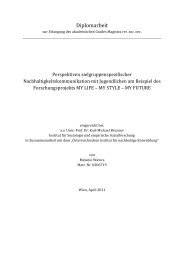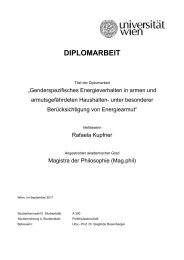The relevance of energy storages for an autarky of electricity supply ...
The relevance of energy storages for an autarky of electricity supply ...
The relevance of energy storages for an autarky of electricity supply ...
Create successful ePaper yourself
Turn your PDF publications into a flip-book with our unique Google optimized e-Paper software.
2 Description <strong>of</strong> method <strong>of</strong> approach applied<br />
<strong>The</strong> applied method <strong>for</strong> this Master <strong>The</strong>sis c<strong>an</strong> be described in five steps, as follows.<br />
1. Criteria <strong>for</strong> assessment <strong>of</strong> storage technologies<br />
At the beginning, several criteria are raised which are commonly used to assess<br />
different storage technologies.<br />
2. Description <strong>an</strong>d assessment <strong>of</strong> storage technologies<br />
In the second step, the storage technologies (Pumped Hydroelectric Storage,<br />
Compressed Air Energy Storage, Hydrogen Storage) are compared, using criteria<br />
raised (see chapter 4.2 Evaluation Criteria).<br />
3. Comparison Dem<strong>an</strong>d Side/Supply Side<br />
Dem<strong>an</strong>d side<br />
In the third step, load curves <strong>for</strong> the const<strong>an</strong>t <strong>an</strong>d the Growth scenario <strong>for</strong> the<br />
<strong>electricity</strong> dem<strong>an</strong>d in 2050 are calculated. For this calculation e-control data <strong>for</strong><br />
the year 2010 are used <strong>an</strong>d allocated to 2050 values from the feasibility study<br />
Energie Autarkie 2050. <strong>The</strong> result is <strong>an</strong>nual, monthly, <strong>an</strong>d daily data on<br />
<strong>electricity</strong> dem<strong>an</strong>d <strong>for</strong> 2050 <strong>an</strong>d corresponding load curves.<br />
Supply Side<br />
<strong>The</strong> feasibility study Energie Autarkie 2050 provides <strong>an</strong>nual <strong>an</strong>d monthly values<br />
<strong>of</strong> the <strong>electricity</strong> mix <strong>for</strong> both scenarios, Const<strong>an</strong>t <strong>an</strong>d Growth. <strong>The</strong>se values are<br />
insufficient <strong>for</strong> comparison <strong>of</strong> dem<strong>an</strong>d <strong>an</strong>d <strong>supply</strong> on a daily basis. <strong>The</strong>re<strong>for</strong>e,<br />
daily data are based on average values, except the <strong>electricity</strong> <strong>for</strong> photovoltaic.<br />
As <strong>electricity</strong> <strong>supply</strong> from photovoltaic varies between summer <strong>an</strong>d winter as<br />
well as during day <strong>an</strong>d night, it is necessary to calculate the precise curves <strong>of</strong><br />
<strong>electricity</strong> production from this <strong>energy</strong> carrier as it has a high impact on the<br />
storage dem<strong>an</strong>d during the course <strong>of</strong> a year <strong>an</strong>d <strong>of</strong> a day. Due to the fact that no<br />
detailed daily <strong>electricity</strong> <strong>supply</strong> curves <strong>for</strong> photovoltaic are provided by the<br />
feasibility study, these values have to be calculated by the author within the<br />
7
















